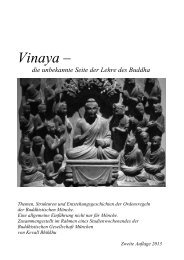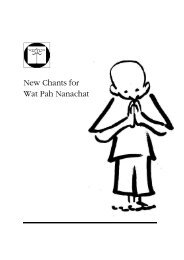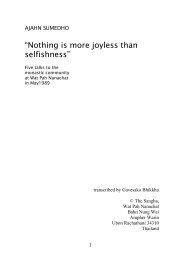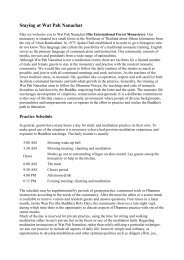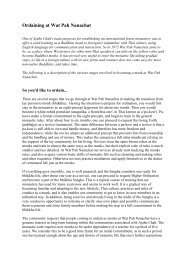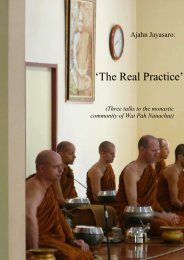Luang Por Liem: The Ways of the Peaceful - Wat Pah Nanachat
Luang Por Liem: The Ways of the Peaceful - Wat Pah Nanachat
Luang Por Liem: The Ways of the Peaceful - Wat Pah Nanachat
You also want an ePaper? Increase the reach of your titles
YUMPU automatically turns print PDFs into web optimized ePapers that Google loves.
person that is accomplished and pure in <strong>the</strong> qualities and virtues<br />
<strong>of</strong> a true Sangha member.<br />
Speaking <strong>of</strong> ‘Sangha’; it is worth mentioning that Sangha<br />
doesn’t have anything to do with specific, individual monks.<br />
When speaking about <strong>the</strong> Sangha in its conventional sense<br />
(sammuti-sangha), <strong>the</strong> Buddha didn’t refer to certain monks.<br />
Sammuti-sangha merely means a group <strong>of</strong> four or more monks; a<br />
sufficient number to be able to perform communal duties. This is<br />
one way <strong>the</strong> Buddha defined ‘Sangha’. But in what <strong>the</strong> Buddha<br />
called <strong>the</strong> ariya-sangha, <strong>the</strong> group <strong>of</strong> <strong>the</strong> Noble Enlightened<br />
Beings, <strong>the</strong> word ‘Sangha’ is related to <strong>the</strong>ir realisations <strong>of</strong> <strong>the</strong><br />
Dhamma. In that context <strong>the</strong> Buddha did refer to certain<br />
individuals: those that no longer fall under <strong>the</strong> power <strong>of</strong> <strong>the</strong><br />
Worldly Dhammas, or those that are not prone to agati and<br />
<strong>the</strong>refore progress with right practice – namely: those who walk<br />
<strong>the</strong> Middle Way. <strong>The</strong> Middle Way doesn’t follow <strong>the</strong> course <strong>of</strong><br />
Worldly Dhammas. <strong>The</strong>se are <strong>the</strong> paths <strong>of</strong> householders and<br />
ordinary unenlightened beings. If our behaviour is not yet<br />
accomplished in <strong>the</strong> Dhamma, <strong>the</strong>re will always be elements <strong>of</strong><br />
agati. So in this matter <strong>of</strong> changing one’s behaviour, what we<br />
should do is have a look at ourselves and evaluate our own<br />
feelings. Observing o<strong>the</strong>r people can take us far away from<br />
relating to ourselves in a way where we can see <strong>the</strong> Dhamma.<br />
This is an interesting aspect <strong>of</strong> Dhamma: how is it possible<br />
that good and bad feelings arise, or happiness and suffering?<br />
Happiness, according to our way <strong>of</strong> thinking, is positive, and for<br />
us who haven’t yet reached <strong>the</strong> level where one truly feels<br />
content, anything that is dukkha is undesirable. But those who are<br />
accomplished and free from <strong>the</strong> mind states <strong>of</strong> worldly,<br />
110



